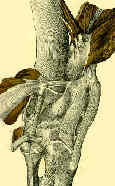- See:

- Lateral Compartment of the Knee:
- Frx of Proximal Fibula:
- Varus Stress Testing:
- Discussion:
- lateral collateral ligament is primary restraint to varus angulation;
- LCL also acts to resist Internal Rotation forces;
- cutting of LCL in combination w/ either anterior or PCL results in large increase in varus opening;
- Varus Stress Testing:
- testing w/ extension:
- LCL resists approximately 55 % of applied load at full extension;
- cruciate ligaments (primarily ACL) resist approx 25% of moment at full extension;
- significant instability in full extension indicates complete LCL tear as well as a tear of either the ACL or PCL ligaments;
- note that LCL instability in extension which occurs with peroneal palsy is a knee dislocation until proven otherwise;
- testing w/ 30 deg flexion:
- role of LCL increases w/ joint flexion, as posterolateral structures become lax;
- w/ joint flexion, resistance by ACL decreases, but large forces are found in PCL at 90 degrees of flexion;
- LCL is primary restraint to varus stress at 5 deg & 25 deg flexion;
- lateral capsular structure provide secondary support;
- iliotibial band & popliteus muscles have dynamic stabilizing role;
- postero-lateral instability: (w/ intact PCL)
- expect to find increased varus rotation and external rotation at 30 deg of knee flexion;
- isolated release of the lateral collateral ligament results in increased external tibial rotation at 30 degrees
- similarly, the same knee flexed to 90 deg will demonstrate decreased varus and external rotaion moments;
- in contrast, w/ increased varus rotation & external rotation moments at both 30 & 90 deg of flexion, then there are tears
of PCL & posterolateral corner;
- one plane lateral instability:
- one plane lateral instability is apparent on varus stress testing when knee opens on the lateral side;
- indicates disruption of lateral capsular ligament, LCL, biceps tendon, iliotibial band, arcuate & popliteus complex, ACL, &
commonly PCL;
- this is major instability approaching severity of disloation;
- references:
- Tests for posterolateral instability of the knee in normal subjects. Results of examination under anesthesia.
- A test for knee posterolateral rotatory instability.
- Classification of knee ligament instabilities. Part II. The lateral compartment.
- Surgical Repair:
- ref: Repair versus reconstruction of the fibular collateral ligament and posterolateral corner in the multiligament-injured knee.
- Surgical Reconstruction:
- allograft reconstruction:
- w/ chronic posterolateral injury, Achilles tendon allograft may be indicated;
- main goal is to create a checkrein to external rotation;
- at the level of Gerdy's tubercle, a bone tunnel is created in the posterolateral tibia, just medial to the fibular head;
- attachment of the IT band to the intermuscular septum may have to be freed for optimal exposure;
- allograft bone plug (9 mm graft and tendon) is contoured to fit the tunnel, and is secured w/ an interference screw;
- tendinous portion of the graft is then secured in the region of the popliteus insertion w/ a bone anchor;
- anchor site should not allow more than 3 mm of motion w/ knee flexion and extension;
- with this technique, the strong stability provided by the allograft may help compensate for disruption of the arcuate complex;
- references:
- Reconstruction of the lateral collateral ligament of the knee with patellar tendon allograft. Report of a new technique in combined ligament injuries.
- Biomechanical analysis of an isolated fibular (lateral) collateral ligament reconstruction using an autogenous semitendinosus graft.
- Editorial Commentary: Small Incisions Can Make Big Mistakes: Knee Lateral Collateral Ligament Reconstruction Is All About the Anatomy!
Anatomy of the junction of the vastus lateralis tendon and the patella.
The incidence of fabellae in osteoarthrosis of the knee.
Year Book: Lateral Ligament Injury of the Knee.
The structure of the posterolateral aspect of the knee.
The fibular collateral ligament-biceps femoris bursa. An anatomic study.

